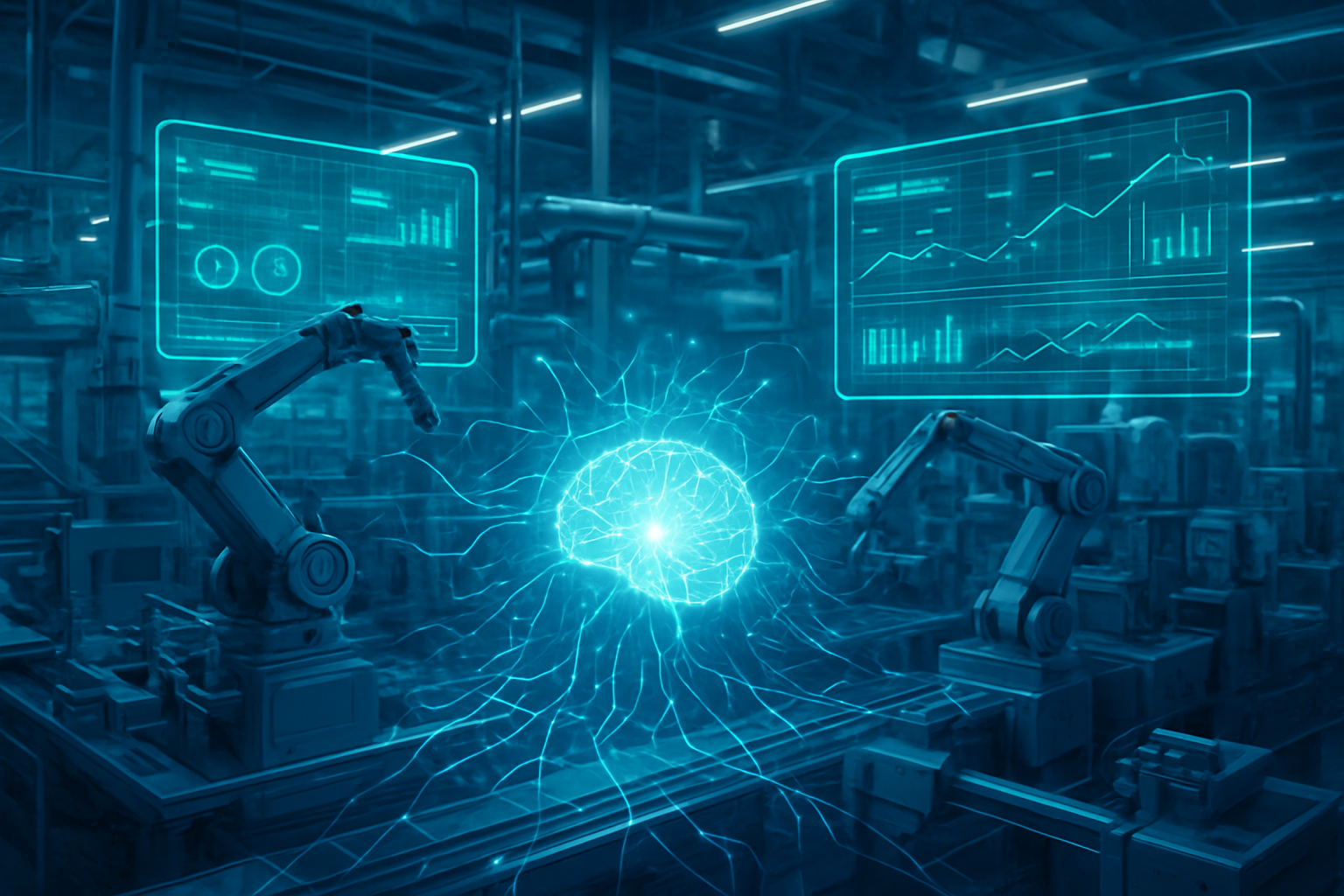The landscape of artificial intelligence is undergoing a profound transformation with the emergence of Industrial AI, a specialized domain moving beyond general-purpose applications to deliver tangible, measurable value in complex industrial environments. This evolution, spearheaded by companies like IFS (STO: IFS), is redefining how sectors such as manufacturing, energy, and transportation optimize operations, enhance efficiency, and drive innovation. Unlike its generative AI counterparts, Industrial AI is purpose-built to tackle the unique challenges of industrial settings, promising a future where precision, reliability, and measurable outcomes are paramount.
IFS, a global enterprise software company, has strategically positioned itself at the forefront of this shift with its IFS.ai platform. By embedding over 200 AI-powered capabilities natively within IFS Cloud, the company is enabling intelligent automation and data-driven decision-making across critical industrial operations. This targeted approach, focusing on six specific industries, highlights a departure from broad AI solutions towards highly tailored applications that address sector-specific complexities, emphasizing domain-specific knowledge, rigorous data quality, and continuous validation of AI models to mitigate issues like "hallucinations."
Technical Deep Dive: IFS.ai and the Industrial AI Advantage
Industrial AI, as embodied by IFS.ai, integrates machine learning, deep learning, and the Industrial Internet of Things (IIoT) to analyze vast quantities of data from industrial processes, machinery, sensors, and human activity. Its technical prowess lies in its ability to process this data in real-time, delivering actionable, role-specific insights that empower smarter and faster decision-making. This contrasts sharply with previous approaches that often relied on retrospective analysis or more generalized AI models lacking the contextual understanding crucial for industrial precision.
A key differentiator for IFS.ai is its deep integration within core enterprise software platforms like Enterprise Resource Planning (ERP), Enterprise Asset Management (EAM), and Service Management (FSM and ITSM). This native embedding allows Industrial AI to act as an integral part of existing workflows, transforming raw operational data into meaningful insights that drive efficiency and reduce costs. For instance, IFS's Resolve solution, powered by Anthropic's Claude, can interpret multi-modal data—video, audio, temperature, pressure, schematics—to predict and prevent faults faster, shifting from reactive repairs to proactive maintenance. This capability significantly surpasses the general content generation or creative tasks typically associated with traditional generative AI, which, while powerful, often require human oversight for accuracy and context in critical industrial applications.
The initial reactions from the AI research community and industry experts underscore the significance of this specialized approach. There is a growing consensus that while generative AI has captured public imagination with its creative capabilities, Industrial AI represents the "workhorse" that keeps critical infrastructure running and drives towards a sustainable future. The focus on domain-specific knowledge and rigorous data governance within IFS.ai is particularly lauded for minimizing the risk of biased or misleading information, a common concern with more generalized AI models.
Competitive Implications and Market Dynamics
The emergence of Industrial AI, particularly with IFS's robust offerings, has significant competitive implications for major AI labs, tech giants, and startups alike. Companies deeply entrenched in industrial sectors, such as Siemens (FWB: SIE) and General Electric (NYSE: GE), stand to benefit immensely by adopting or further developing their own Industrial AI solutions, leveraging their existing domain expertise and customer bases. IFS (STO: IFS), with its focused strategy and integrated platform, is already demonstrating a strong market position, potentially disrupting traditional software providers who have yet to fully embrace specialized AI for industrial applications.
The competitive landscape is being reshaped as the market for Industrial AI is projected to experience a fortyfold increase from $4.35 billion in 2024 to $153.9 billion by 2030. This rapid growth signals a shift from AI merely enhancing efficiency to becoming an indispensable component of modern industry. Tech giants with broad AI capabilities may seek to acquire specialized Industrial AI firms or develop their own targeted solutions to capture a share of this burgeoning market. Startups with innovative Industrial AI technologies could become attractive acquisition targets or forge strategic partnerships with established players, as exemplified by IFS's collaborations with companies like Anthropic and 1X Technologies.
This development also poses a potential disruption to existing products or services that rely on less sophisticated data analysis or manual processes. Industrial AI's ability to automate repetitive tasks, optimize scheduling, and provide real-time insights can render older systems less competitive. Companies that fail to adapt and integrate Industrial AI into their operations risk falling behind in efficiency, cost-effectiveness, and overall operational resilience. The strategic advantage will lie with those who can effectively embed AI into their core enterprise software and leverage it for truly transformative outcomes in their specific industrial contexts.
Wider Significance in the AI Landscape
Industrial AI's rise fits seamlessly into the broader AI landscape as a testament to the technology's maturation and specialization. While early AI milestones focused on general problem-solving and pattern recognition, and more recent breakthroughs in generative AI have emphasized creative content generation, Industrial AI represents a critical pivot towards practical, outcome-driven applications in mission-critical sectors. This trend underscores the idea that AI's true potential lies not just in its ability to mimic human intelligence, but in its capacity to augment and optimize complex real-world systems.
The impacts of Industrial AI are far-reaching, promising significant advancements in areas like supply chain management, asset performance management, and sustainability optimization. By predicting disruptions, optimizing maintenance schedules, and identifying energy-saving practices, Industrial AI contributes directly to operational resilience, cost reduction, and environmental responsibility. This contrasts with the more abstract or consumer-focused impacts of some generative AI applications, highlighting Industrial AI's role in addressing fundamental industrial challenges.
However, the widespread adoption of Industrial AI also brings potential concerns, particularly regarding data privacy, cybersecurity, and the ethical implications of autonomous decision-making in industrial processes. The reliance on vast quantities of sensitive operational data necessitates robust security measures and clear ethical guidelines to prevent misuse or system failures. Comparisons to previous AI milestones reveal that while the underlying technology may share common principles, the application and the stakes involved in Industrial AI are uniquely high, demanding a greater emphasis on reliability, safety, and accountability.
Future Developments and Expert Predictions
Looking ahead, the trajectory of Industrial AI promises exciting near-term and long-term developments. Experts predict a continued deepening of AI integration within industrial software, leading to even more sophisticated automation and predictive capabilities. The concept of "digital twins"—virtual replicas of physical assets—will become increasingly prevalent, offering unprecedented control and precision in asset management. Further advancements in multi-modal data interpretation, as seen in IFS's Resolve solution, will enable AI to understand and react to complex industrial environments with greater nuance.
Potential applications and use cases on the horizon include highly autonomous factories where AI systems manage entire production lines with minimal human intervention, and intelligent energy grids that optimize power distribution based on real-time demand and renewable energy availability. In logistics, AI could orchestrate complex global supply chains, anticipating and mitigating disruptions before they occur. The integration of advanced robotics, facilitated by Industrial AI, will also continue to expand, leading to more flexible and adaptive manufacturing processes.
Despite the promising outlook, several challenges need to be addressed. Ensuring data quality and governance across diverse industrial data sources remains a critical hurdle. The development of robust and explainable AI models that can be trusted in high-stakes industrial environments is also paramount. Furthermore, upskilling the workforce to effectively interact with and manage AI-powered systems will be crucial for successful implementation. Experts predict that the future will see a "Composite AI" approach, where the strengths of Industrial AI are combined with those of generative AI to create comprehensive solutions that balance operational efficiency with innovation and creativity.
A Comprehensive Wrap-Up: The Dawn of a New Industrial Era
The emergence of Industrial AI, particularly through the innovations championed by IFS, marks a pivotal moment in the history of artificial intelligence. It signifies a shift from generalized AI applications to highly specialized, outcome-driven solutions that are revolutionizing real-life business applications across critical sectors. The key takeaway is that Industrial AI is not merely an incremental improvement; it is a fundamental transformation in how industries operate, promising unprecedented levels of efficiency, optimization, and resilience.
This development's significance in AI history lies in its ability to bridge the gap between theoretical AI capabilities and practical, measurable business value in complex industrial settings. While traditional generative AI has excelled in creative and content-related tasks, Industrial AI stands out as the "workhorse" that ensures operational continuity, optimizes physical assets, and drives towards a sustainable future. Its emphasis on precision, reliability, and contextualized intelligence within operational workflows positions it as a cornerstone of modern industry.
In the coming weeks and months, it will be crucial to watch for further advancements in Industrial AI platforms, particularly regarding their ability to integrate with emerging technologies like advanced robotics and edge computing. The expansion of strategic partnerships within the Industrial AI ecosystem will also be a key indicator of market growth and innovation. Ultimately, the long-term impact of Industrial AI will be seen in its capacity to not only enhance existing industrial processes but to fundamentally reshape entire industries, fostering a new era of intelligent and sustainable operations.
This content is intended for informational purposes only and represents analysis of current AI developments.
TokenRing AI delivers enterprise-grade solutions for multi-agent AI workflow orchestration, AI-powered development tools, and seamless remote collaboration platforms.
For more information, visit https://www.tokenring.ai/.









